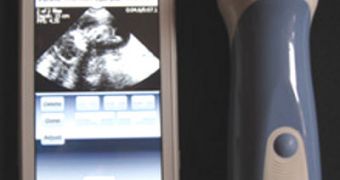A team of engineers is awaiting final approvals from the United States government to begin selling a new type of highly-portable, ultrasounds generators, that can be connected directly to cell phones and other devices in Wi-Fi networks.
The basis for the new handheld devices we set about two years ago, when computer engineers from the Washington University in St. Louis (WUSL) created a prototype ultrasound device that reached an amazing level of mobility.
It represented the first time that such a device was connected directly to a cell phone, and the team continued working on improving the apparatus until it reached a point where it could market it.
The group is currently waiting on final approvals from the US Food and Drug Administration (FDA), and plans to distribute the new equipment starting next year, Technology Review reports.
Undoubtedly, the most important application will be in emergency responses to natural or man-made disasters, when rescue workers will be able to determine the extent of a victim's internal injuries directly on-site.
The images thus collected could be sent to the hospital ahead of the ambulance, so that doctors don't waste precious time trying to figure out what goes on inside the patient.
The smart-phone ultrasound prototype was developed with grant money provided by a group lead by the former head of external research at Microsoft, Sailesh Chutani. He is now a co-founder of Mobisant with prototype developer David Zar.
Chutani says that, even if Microsoft is not backing up the new company, some funds have been gathered from would-be customers, such as nearby clinics. These institutions don't have the money to pay more than $50,000 for an ultrasound machine.
At first, the new mobile devices will cost between $5,000 and $10,000, but plans are to reduce costs by more than half over the next three years. Several variants, custom tailored for different applications, will be made available.
Valley Medical Center vascular surgeon Oliver Aalami, who is beta-testing the device, says that it's made his work a lot easier. He no longer has to use the large cumbersome ultrasound device that the Renton, Washington-based Center has.
“To use that machine, I have to wheel it out of the OR, and then take the elevator up four floors to the ICU,” he says. But the new device can be carried inside an average pocket, and so it is now his favorite.
“When you're in a tight room, you can't always get an ultrasound machine in without taking chairs out and moving the bed,” the expert adds.
The new device “saves me time and lets me worry about other things. I can focus on the rest of my practice,” Aalami concludes.

 14 DAY TRIAL //
14 DAY TRIAL //